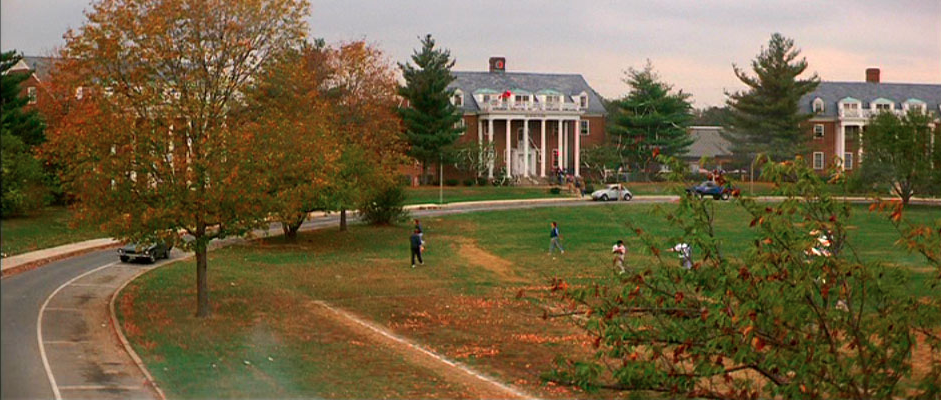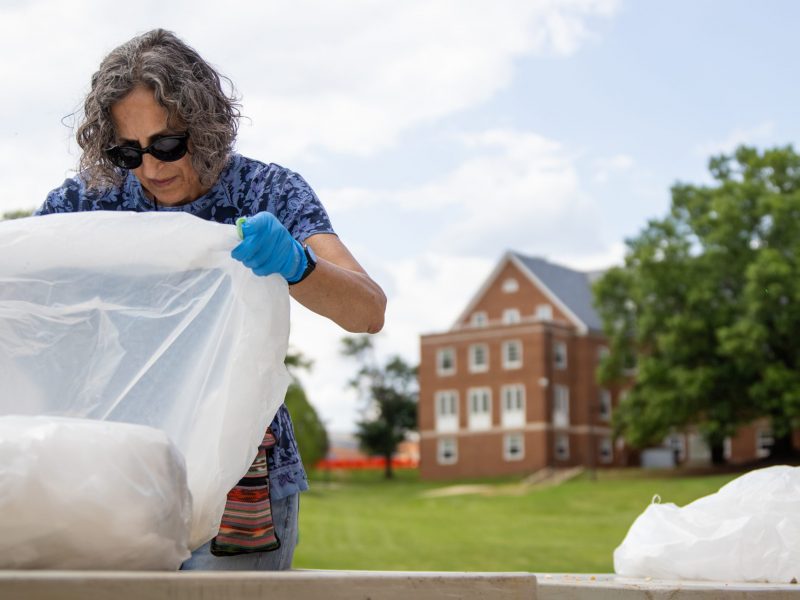
Fraternity Row
If you look at the 1985 edition of The Terrapin yearbook, you’ll notice that even after 30 years, some aspects of life at this university never change.
Students and football fans packed campus parking lots on game days to tailgate before flooding Byrd Stadium. R.J. Bentley’s was the go-to haunt on Route 1 for thirsty Terps. Students protested for causes they cared about, participated in charity dance-offs to fight cancer and lounged around McKeldin Mall on sunny days.
It was the first year students were able to register for classes using a computer. Commencement ceremonies had just begun giving personalized experiences for students by offering multiple graduation ceremonies. But though there is no mention of it in the yearbook, that summer, the campus got a taste of Hollywood.
When Georgetown University officials refused to allow the crew of the movie St. Elmo’s Fire to film on its campus, the crew instead used this university to stand in. According to the university archives, the Sigma Kappa sorority chapter house stood in for an academic building while the grassy lawn of Fraternity Row stood in for the mall in a shot early in the film.
It’s been nearly 30 years since the release of St. Elmo’s Fire, the Brat Pack film that shows the ‘80s teen stars growing up. Though critics mostly panned the film, it touches on a period of life that most Brat Pack films and even modern movies shy away from: the onset of adulthood. St. Elmo’s Fire was one of the first films to look at the period of transition between college and post-grad life, which has been the coming-of-age point for many young adults in the past several decades.
For many in my generation, the idea of starting a career right out of high school is preposterous. While movies love to show the crazy parties and a cappella tournaments of the undergraduate career, they fail to address what happens after we’ve managed to wrap up our finals and throw the last red Solo cups away. Life does not fade to black after we hug our friends goodbye one final time at graduation, and St. Elmo’s Fire embraces this idea. The movie opens with a shot of friends walking together at graduation; what looks to be the happy ending of one story is merely the backdrop to another narrative — one laden with uncertainty, mistakes and regret.
The film seems to pose a question to the audience: What happens when the identities we spend four years carefully concocting are put to the test in the harsh light of the world outside the shelter of the university? Though the movie has aged a bit, the situations and characters presented in the film feel very familiar even today.
Andrew McCarthy plays the brooding writer who wears his cynicism as a badge of honor. Despite being out of college, McCarthy is trapped in the teen angst that most usually outgrow by sophomore year.
Playing complete foils to their characters in The Breakfast Club, Ally Sheedy and Judd Nelson portray the typical college couple that everyone assumes will stay together forever after graduation. Nelson’s Alec is the spitting image of every ambitious government and politics major around campus. Ruthless and morally flexible, Alec is the ultimate sellout; formerly the president of the Young Democrats, he is willing to work for a Republican senator to reap the benefits of a bigger paycheck — a nightmare, but a very real choice for many students working in politics.
A dreamy young Emilio Estevez portrays Kirby, who works as a waiter at St. Elmo’s Bar (the Cornerstone of Georgetown) to pay his way through law school.
The movie features quite a few moments that seem woefully removed from the situations of modern college graduates. Perhaps the biggest slap in the face is the bevy of shots of spacious apartments the recent grads were living in. Comfortable living is a dream for many students following college, but the ridiculously roomy apartments and lofts in Washington provided a bit of false hope for me as I watched this movie early in my undergraduate career.
What’s perhaps most interesting — aside from bad-boy Rob Lowe’s flowing mane — is how the lives of these characters seem fairly static after graduation. Aside from having jobs, they all act as if they are still in college. They live in the vicinity of their alma mater, and until the end of the movie, they continue to hang out at the same watering hole they did as students. While quite a few Terps go on to get jobs in the area, many of us are separated from our friends after graduation as we head either home or beyond the area to seek a new career.
While St. Elmo’s Fire might not be the best post-college movie, it’s an important reminder to undergrads to prepare for the changes that await after graduation. While it’s not bad to hold onto the people and place we enjoyed, we must not forget to embrace change and continue growing, even when the so-called “best years of our lives” are behind us.



